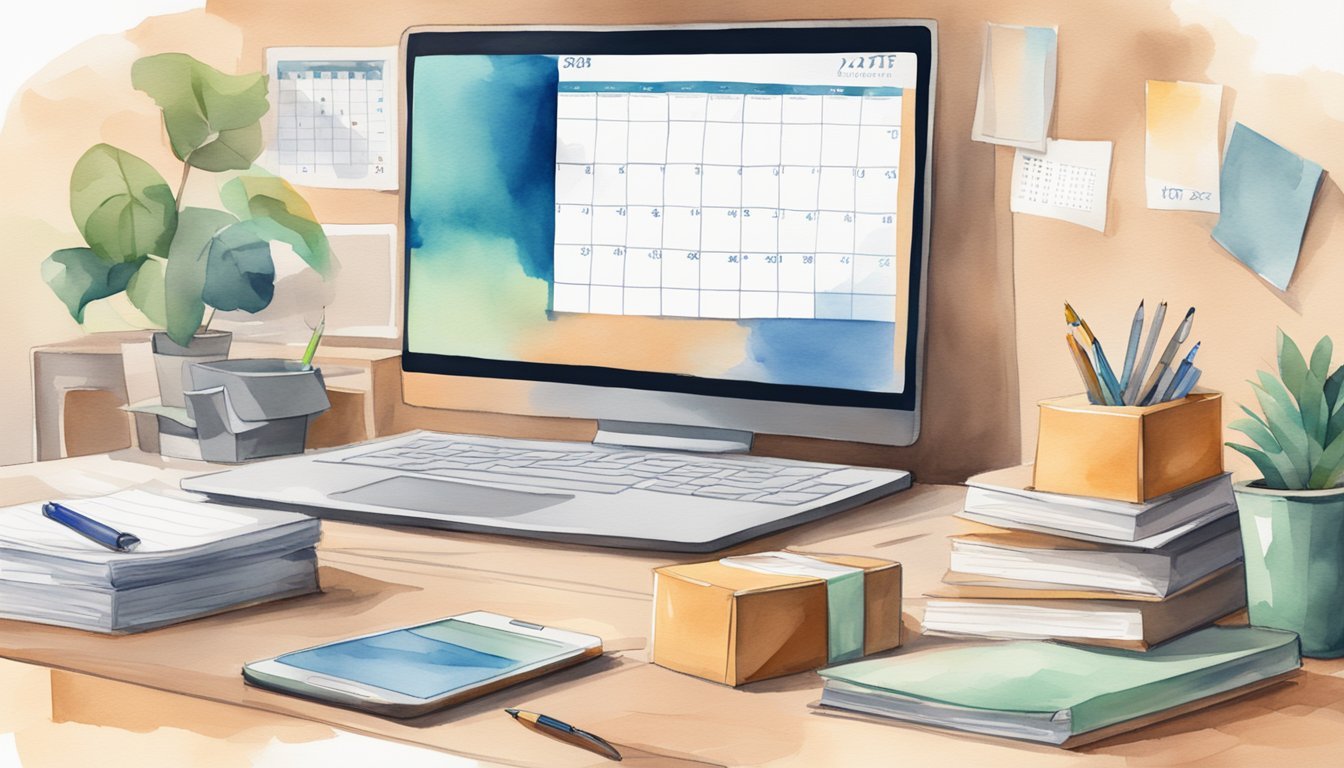How to Start a Dropshipping Business: 8 Steps to Success – Your Quick Guide

Starting a dropshipping business can be a great way to dive into the world of ecommerce without the risks that come with managing inventory.
The appeal of dropshipping lies in its simplicity and low startup costs, making it an attractive option for aspiring entrepreneurs.

You don’t need to worry about storing, packing, or shipping products, which means you can focus more on marketing and growing your business.
This guide will walk you through the essential steps to get your dropshipping business up and running successfully.
1) Research Your Niche
To start a dropshipping business, you need to find the right niche.
Your niche is the specific market or industry you will target with your products.
Begin by identifying what interests you.
This can make your business journey enjoyable.
Think about hobbies, problems you want to solve, or trends you notice.
Next, assess the competition.
You can do this by searching online to see how many businesses are already selling similar products.
If the market seems too crowded, you might want to find a niche with less competition.
Check the demand for your chosen niche.
Use tools like Google Trends to see if people are searching for products related to your niche.
High search volumes can indicate good demand.
Look at existing customer reviews on platforms like Amazon or eBay.
These reviews can give you insights into what customers like and dislike about similar products.
Use this information to improve your product offerings.
It’s also important to consider the profitability of the niche.
Calculate potential profit margins by comparing the cost of products from suppliers with their selling prices online.
Selecting a niche isn’t just about following trends.
Ensure it’s something you feel passionate about or have an interest in, which can make it easier to market your products.
Take your time with this step.
The more research you do, the better prepared you’ll be to succeed in your dropshipping business.
2) Find Reliable Suppliers

Finding reliable suppliers is key for your dropshipping business.
You need suppliers who deliver products on time and maintain good quality.
One way to find great suppliers is by doing research.
Start by checking out suppliers that other successful businesses use.
Look for reviews and testimonials.
Websites like Alibaba and AliExpress are good places to find potential suppliers.
There are different types of suppliers available for dropshipping.
You may work with manufacturers, wholesale suppliers, or dropshipping aggregators.
Identifying which type suits your needs will help you find the best partner.
For example, wholesale suppliers might offer bulk deals that save you money.
You can also attend trade shows to meet suppliers in person.
This lets you see the products and negotiate terms directly.
Trade shows are great opportunities to ask questions and build relationships.
Always ask potential suppliers for samples before making any big decisions.
This helps you assess the product quality firsthand.
Monitoring their communication speed and reliability during this phase can offer insight into how they might handle future orders.
Consider using directories like SaleHoo or Oberlo to find vetted suppliers.
These directories list suppliers that have been checked for reliability and performance.
Remember to maintain clear communication with your suppliers.
Good communication helps solve any issues quickly and keeps your business running smoothly.
Finally, it might be a good idea to use multiple suppliers to avoid putting all your eggs in one basket.
This way, you have options if one supplier has issues.
3) Set Up Your Online Store
Your online store is the heart of your dropshipping business, showcasing your products and enabling purchases.
Start by choosing an ecommerce platform like Shopify, WooCommerce, or BigCommerce that fits your needs and budget.
Pick a clean, easy-to-navigate theme for your store.
This helps keep customers interested and makes shopping simple.
Customize your store’s look with your logo, brand colors, and fonts to make it unique.
Add high-quality images and detailed descriptions of your products.
Customers need to see what they are buying, so ensure your photos are clear and your descriptions are accurate.
Include key details like size, color, and material.
Organize your products into categories that make sense.
This helps visitors find what they are looking for quickly.
For example, if you are selling clothes, you might have categories like tops, bottoms, and accessories.
Set up the payment methods you will accept.
Most platforms support various payment options like PayPal, credit cards, and Apple Pay.
Make sure it’s easy for customers to complete purchases.
Don’t forget to create important pages like About Us, Contact, and Return Policy.
These pages help build trust with your customers.
Ensure your contact information is easy to find.
Lastly, check that your store works well on mobile devices.
Many people shop on their phones, so you want your store to look good and be easy to use on smaller screens.
By setting up your online store properly, you set a strong foundation for your dropshipping business.
For more detailed steps on building an ecommerce store, see this 9-step guide.
4) Choose a Shipper

Picking the right shipper is essential for your dropshipping business.
A good shipper ensures that products reach customers on time and in good condition.
First, look for shippers who offer reliable service and have good reviews.
Check their delivery times and see if they offer tracking information.
Reliable tracking helps build trust with your customers.
Consider the shipping costs.
Some shippers might be cheaper but slower.
You need to balance cost and speed to keep your customers happy without breaking the bank.
You should also think about the areas the shipper covers.
Make sure they can deliver to your target markets.
If you’re selling internationally, ensure they handle international shipping efficiently.
Communicate with your potential shipper.
Ask questions about their process and how they handle issues like lost or damaged items.
Good communication can prevent future problems.
It’s also a good idea to test their service yourself.
Place a test order to see how the process goes from start to finish.
This will give you a firsthand look at how they operate.
Finding the right shipper might take some time, but it’s worth the effort.
A reliable shipper can make a big difference in the success of your dropshipping business.
For more detailed steps on starting a dropshipping business, check out this guide.
5) Design Your Store
First, you need to choose a clean and easy-to-navigate template for your online store.
Many ecommerce platforms offer free templates that look professional.
Customizing your template with your brand colors and logo makes your store unique.
Aim for a simple and attractive design that matches your brand’s vibe.
Pay attention to how you organize your products.
Use clear categories and easy-to-understand names.
This helps customers find what they are looking for quickly.
Adding high-quality images and detailed descriptions for each product is essential.
These elements showcase your products and make them appealing to customers.
Make sure your store is mobile-friendly.
Many shoppers use their phones to make purchases, so your site must function well on all devices.
Integrate essential features like search bars, customer reviews, and product filters.
These tools improve the shopping experience and your store’s credibility.
Don’t forget to test your store thoroughly before launching.
Check that all links work, and that the checkout process is smooth and straightforward.
Using these steps will help you create a professional and user-friendly store that attracts and retains customers.
For more details on this process, check out this guide.
Designing your store well is crucial for success in dropshipping.
Follow these tips, and your store will be ready to welcome customers.
6) Optimize Product Listings
To attract customers and increase sales, you need to optimize your product listings.
Start by using high-quality images.
Make sure they are clear and showcase the product from different angles.
Write compelling product descriptions.
Use simple and clear language.
Highlight the benefits and features of the product.
Include any specifications, dimensions, or materials to give customers a complete understanding.
Use keywords in your product titles and descriptions.
This helps your products appear in search results.
Do some research to find out what terms your potential customers are searching for.
Set competitive prices.
Look at what your competitors are charging and adjust your prices accordingly.
Make sure to factor in all costs, including shipping and fees.
Ensure your listings are easy to navigate.
Use bullet points for key information.
Break up text into short paragraphs.
This makes it easier for customers to read and understand the details.
Include customer reviews if possible.
Positive reviews build trust and show potential buyers that others are satisfied with your product.
Periodically update your listings.
If you get new images or better keywords, make changes to keep your listings current.
Stay on top of trends and customer preferences.
This keeps your store relevant and appealing.
By following these tips, you can make your product listings more attractive and effective, leading to better sales and customer satisfaction.
For more on setting up your dropshipping store, visit How To Start a Dropshipping Business: 9-Step Guide.
7) Set Up Payment Gateway
Setting up a payment gateway is crucial for your dropshipping business.
A payment gateway allows you to accept online payments from your customers.
First, choose a reliable payment gateway that fits your needs.
Popular options include Shopify Payments, PayPal, and Stripe.
Make sure the gateway supports multiple payment methods like credit cards, PayPal, and Apple Pay.
Next, integrate the payment gateway with your online store.
If you’re using an ecommerce platform like Shopify, the process is simple.
Just follow the platform’s guidelines to connect your chosen gateway to your store.
Each gateway will have its own setup instructions, so ensure you follow them step-by-step.
Make sure the payment gateway is secure.
Look for features like SSL certificates and data encryption.
These features help protect your customers’ payment information.
A secure gateway also boosts trust and can reduce cart abandonment.
Check the fees associated with the payment gateway.
Each gateway charges different fees for transactions.
Pay attention to these fees as they can affect your profit margins.
Compare different options to find the most cost-effective one for your business.
Test the payment gateway before going live.
Make a small transaction to check if everything works smoothly.
Ensure that both you and your customers get confirmation emails for successful payments.
After setting up, monitor the payment gateway regularly.
Look out for any issues or errors in transactions.
Act quickly to resolve any problems to keep your business running smoothly.
8) Launch and Market

Congrats, you’ve done a lot of work to get this far! Now it’s time to launch your dropshipping store and let the world know about it.
First, double-check that your website is functioning perfectly.
Ensure all product pages, payment gateways, and customer service options are live and working.
Next, make use of social media to promote your store.
Create engaging content and use ads to reach your target audience.
Platforms like Facebook, Instagram, and TikTok are great for getting the word out.
Consider starting a blog on your store’s website.
This can help with SEO and bring organic traffic to your site.
Write posts about your niche, product highlights, and any industry news.
Email marketing is another powerful tool.
Collect email addresses through sign-up forms and offer incentives like discounts or free shipping.
Send regular newsletters to keep your audience informed and engaged.
Don’t forget to leverage influencers.
Partner with popular personalities in your niche to boost your brand.
Influencers can provide authentic reviews and reach a wide audience.
You can also use tools like Google Ads to target specific keywords related to your products.
This can drive targeted traffic to your site and increase sales.
Tracking and analyzing your marketing efforts is crucial.
Tools like Google Analytics can help you see what’s working and what needs adjustment.
Keep tweaking your strategies to maximize your reach and sales.
Lastly, ensure you provide excellent customer service.
Happy customers are more likely to return and recommend your store to others.
Respond quickly to inquiries and resolve any issues promptly.
Choosing Your Niche

Picking the right niche is one of the most important steps in starting a dropshipping business.
It involves understanding the demand for products and evaluating the competition.
Research Market Demand
To find the best niche, start by researching what people are already looking to buy.
One way to do this is by using tools like Google Trends and market research reports.
These tools can show you the popularity of different products over time, which can help you decide what might sell well.
Look for products with consistent demand and avoid those that are fads.
This ensures you have a stable market.
You can also browse popular online marketplaces like Amazon to see what products have high ratings and reviews.
Finally, consider seasonal trends.
Some products only sell well at certain times of the year.
If you choose a seasonal product, you’ll need to plan your marketing and inventory accordingly.
Identify Competitors
After you have an idea of what niche you want to target, it’s crucial to identify your competitors.
Check out other online stores that are selling the same or similar products.
Look at their product listings, prices, and customer reviews.
Make a list of the top competitors and visit their websites.
Analyze their site design, user experience, and marketing strategies.
This will give you an idea of what works well and what doesn’t in your chosen niche.
Understanding your competition also helps you find gaps in the market.
Maybe there are products that aren’t being offered or customer complaints that you can address.
By identifying your competitors, you can create a unique selling proposition (USP) that sets your business apart.
Setting Up Your Online Store
Creating an online store involves selecting a reliable platform, designing a user-friendly layout, and carefully adding products.
These steps ensure your store is attractive and easy for customers to use.
Selecting a Platform
Choosing the right platform for your dropshipping business is crucial.
Platforms like Shopify offer user-friendly interfaces and essential tools.
Another option is Wix, known for its customization features and ease of use.
Take time to compare pricing, features, and integrations.
Look for platforms that support multiple payment gateways and offer strong customer support.
Ensure the platform is scalable to grow with your business needs.
Designing Your Store
Design is important for capturing visitors’ attention and keeping them.
Start with a clean, professional layout.
Choose a theme that fits your brand identity.
Many platforms offer free and paid themes that you can modify.
Include high-quality images and clear descriptions for your products.
Focus on easy navigation with clear categories and a simple menu.
Also, consider mobile optimization since many customers shop on their phones.
Adding Products
When adding products, ensure they match the niche you’ve chosen.
Write detailed product descriptions that highlight key features and benefits.
Use bullet points for easier readability.
Include multiple high-quality images from different angles.
Set up a logical pricing strategy.
Check the competition and factor in your costs to determine prices.
Consider offering discounts or promotions to attract customers early on.
Make sure the checkout process is smooth and straightforward to minimize cart abandonment.
By following these steps, you can set up a professional and appealing online store for your dropshipping business.
Frequently Asked Questions

Starting a dropshipping business involves researching your niche, finding reliable suppliers, and setting up an online store.
Many people wonder about the initial steps, costs, and income potential.
What are the initial steps to kick off a dropshipping venture from scratch?
First, you need to research your niche.
Figure out what products you’ll sell and who your target market is.
Then, find reliable suppliers who provide the products you want.
Once you’ve got that down, set up your online store and start marketing your business.
Can you start a dropshipping business without spending any cash?
Starting without any cash is tough.
You usually need some funds for setting up a website, marketing, and purchasing initial inventory.
However, platforms like Shopify offer free trials, and using social media for marketing can help lower costs.
What’s the best way to set up dropshipping while chilling at my place?
Use an e-commerce platform like Shopify.
It simplifies the process with all the tools you need.
You can design your store, manage products, and take orders all from the comfort of your home.
How do beginners navigate the dropshipping scene successfully?
Start by educating yourself with reliable guides and resources.
Check out articles like this one from Forbes for straightforward steps.
Join dropshipping communities and forums to learn from experienced sellers.
What’s the skinny on the amount of dough you need to fire up a dropshipping biz on Shopify?
On Shopify, expect to spend around $29 per month for the Basic plan.
Additionally, budget for marketing expenses which can vary.
You’ll also need a small amount for initial inventory purchases, as some suppliers require this.
What kind of bank can a dropshipper expect to make on average?
Income can vary widely.
On average, successful dropshippers can make anywhere from a few hundred to thousands of dollars a month.
It largely depends on the products, market demand, and how well you market your store.

